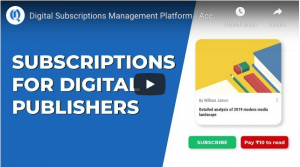
28 July 2020 – Reuter’s digital news publication report states that over 52% of news executives believe that reader revenue is going to be the main source of income going forward. We covered the main findings of the report on our blog here.
Unprecedented times call for unrivaled changes. While traversing this uncertain journey through the global pandemic, ensuring a steady income from reader subscriptions demands that publishers shift the focus of their lens on what suits their readers the best and yet at the same time work their way to also keep their readers/consumers engaged.
Let us look at some ways on how to toggle between ensuring a steady income and providing a quality experience to our consumers:
Collaborate and Co-create
First things first, bring your company on board with the changes. All stakeholders from editors, writers, developers, to project managers must be integrated to create flawless outputs.
Talk about your company/Talk your way
Readers opt for a subscription for very many reasons. Sometimes it is to access information that is available only when subscribed, other times it could be to support quality journalism.
You can convert the vision of your organization and couple it with points on how readers can help fund quality journalism. A telling example is how The New York Times experimented with having journalists explain in detail their reporting process in ads for subscriptions during some of their podcasts. Another example is the messages at the bottom of its articles which are long, conversational, and customized by topic and geography, in The Guardian.
The focus must relentlessly be on the interest of the readers. “Subscription fatigue” is real and much akin to news fatigue. Given that the readers are spoilt for choices and publishers are scrambling for congruous ways to ensure lucrative outcomes, the balance between the two must be gingerly trodden upon. The Wall Street Journal was able to increase subscriptions 10% by simply throwing light on the ease at which subscribers could cancel their subscriptions if need be.
Research from the Media Insight Project highlights the potential paths to subscription, which publishers can use to better target their subscription offerings.
Focus on your content
The single most important point of focus, your content. It cannot be repeated enough that content is what bridges the gap between the subscribers and the creators, and justifiably so. It is the content that must ultimately scream out to the readers for attention and thereby maneuver the readers to pay for it.
You can experiment innovatively with content and adhere to what ensures maximum reader retention and increased subscriptions. One of the most successfully implemented modes includes- providing explainers as cover for big stories. Readers prefer to consume information deconstructed to them, thus explainers always work, a classic example of how The Economist presents news. Another impactful way is going the ‘finite edition’ way. This seemingly works best in the current time, given the prevalence of information overload.
Revenue models differ for every publisher. Freemium models and metered paywalls are seemingly popular among newspapers and magazines. A sudden shift to reader revenue models may not be easy; readers may not be willing to pay immediately as a wide variety of quality journalism continues to be available for free.
Analyzing reader behavior and consumption patterns by using the right analytics is the key to break through the inertia towards paid content.
Furthermore, research from the Center for Media Engagement suggests that we may be thinking about the conversion funnel inadequately. The team behind the report found that
Readers are not heavily persuaded by images of the newspapers’ logos or messages about what they’d lose if they don’t subscribe. Instead, readers are more triggered by messages about what they’d gain from a subscription, such as access to premium-only content.
A recent finding from Reuters also concludes that publishers who build direct relationships with their readers are better able to convince readers to subscribe. Conclusively, a subscription is not a one-time sale but a long-term proposition. Building a strong relationship with your audience is essential to succeed. This calls for factoring in the ease at which content is created, shared, a paywall is executed and the result analyzed. We’ve got it all covered in our products Bold, AccessType and MeType.

This article is reprinted from the Quintype newsletter with permission from Quintype.
This story published by 1 August,2020
















